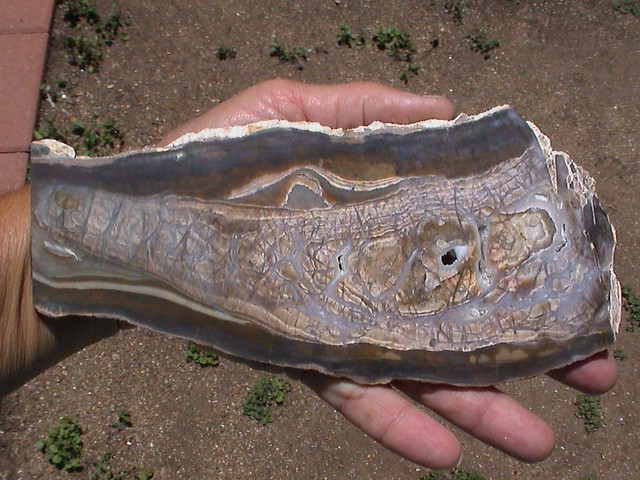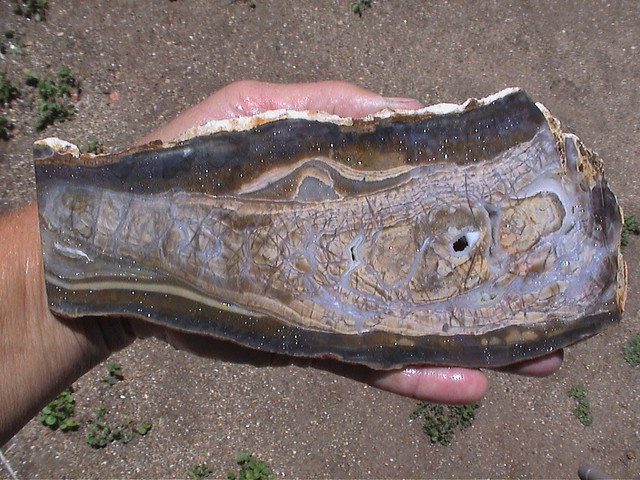|
|
Post by stephan on May 24, 2015 8:53:42 GMT -5
Got in a bidding war with someone on this. I wanted it, damnit! Ended up paying $9. 
A good sized slab, seems pretty solid. Not sure what exactly it is, but looks similar to something I saw in a book. They called it "Scenic Jasper" from Wiley's Well.

Some nice stuff at that auction. Thanks for sharing. The one above looks really cool. I'm thinking some sort of pet wood, maybe? Replaced with jasper and brecciated? |
|
|
|
Post by stephan on May 24, 2015 9:06:18 GMT -5
Chalcedony, huh? So a quartz, not an agate? To answer two questions... 1. Carnelian is red because it contains iron oxide. 2. Chalcedony is cryptocrystalline (or microcrystalline) quartz, just like agate. The difference is that true agate is banded, whereas chalcedony s more of a catch-all term and does not have to be banded. Many "agates" on the market are actually chalcedony, because they lack banding (green tree agate, many plume agates, most Montana moss agate, desert sage agate...). Also from Mindat for agate: "A distinctly banded variety of Chalcedony." So, some carnelian is agate, some is chalcedony. Also, just because rock-namers are so darn nit-picky, the likely reason your bag says "carnelian sorta," is because with the more brownish material, some are likely to say that it is sard. This is one of the weirdnesses of the rock world, because, like carnelian, sard is colored by iron oxide, which gives a range of colors, leading to arguments over what you have. there is overlap and interchangeability of the terms, so someone will tell you you are wrong, no matter what you call it. And to make it even more fun, if you have banded sard, it is called sardonyx.... My head hurts now. ;-) Stephan |
|
|
|
Post by rockpickerforever on May 25, 2015 8:54:34 GMT -5
Some nice stuff at that auction. Thanks for sharing. The one above looks really cool. I'm thinking some sort of pet wood, maybe? Replaced with jasper and brecciated? Thanks, stephan. Could be. I would have loved to have seen the entire piece before it was slabbed, seeing the exterior rind could have been helpful. I know a lot of people puzzled over this, including the guy bidding against me! To answer two questions... 1. Carnelian is red because it contains iron oxide. 2. Chalcedony is cryptocrystalline (or microcrystalline) quartz, just like agate. The difference is that true agate is banded, whereas chalcedony s more of a catch-all term and does not have to be banded. Many "agates" on the market are actually chalcedony, because they lack banding (green tree agate, many plume agates, most Montana moss agate, desert sage agate...). Also from Mindat for agate: "A distinctly banded variety of Chalcedony." So, some carnelian is agate, some is chalcedony. Also, just because rock-namers are so darn nit-picky, the likely reason your bag says "carnelian sorta," is because with the more brownish material, some are likely to say that it is sard. This is one of the weirdnesses of the rock world, because, like carnelian, sard is colored by iron oxide, which gives a range of colors, leading to arguments over what you have. there is overlap and interchangeability of the terms, so someone will tell you you are wrong, no matter what you call it. And to make it even more fun, if you have banded sard, it is called sardonyx.... My head hurts now. ;-) Stephan Thanks again. So carnelian, sard, sardonyx.. The distinction is clear as mud! My head hurts, too. |
|
|
|
Post by stephan on May 27, 2015 0:24:51 GMT -5
Agreed. Clear as mud. Sometimes mindat gets a little grumpy over the number of classifications. I forget which mineral's variant it was, but it was described as "another redundant, needless name..." or something along those lines.
|
|














